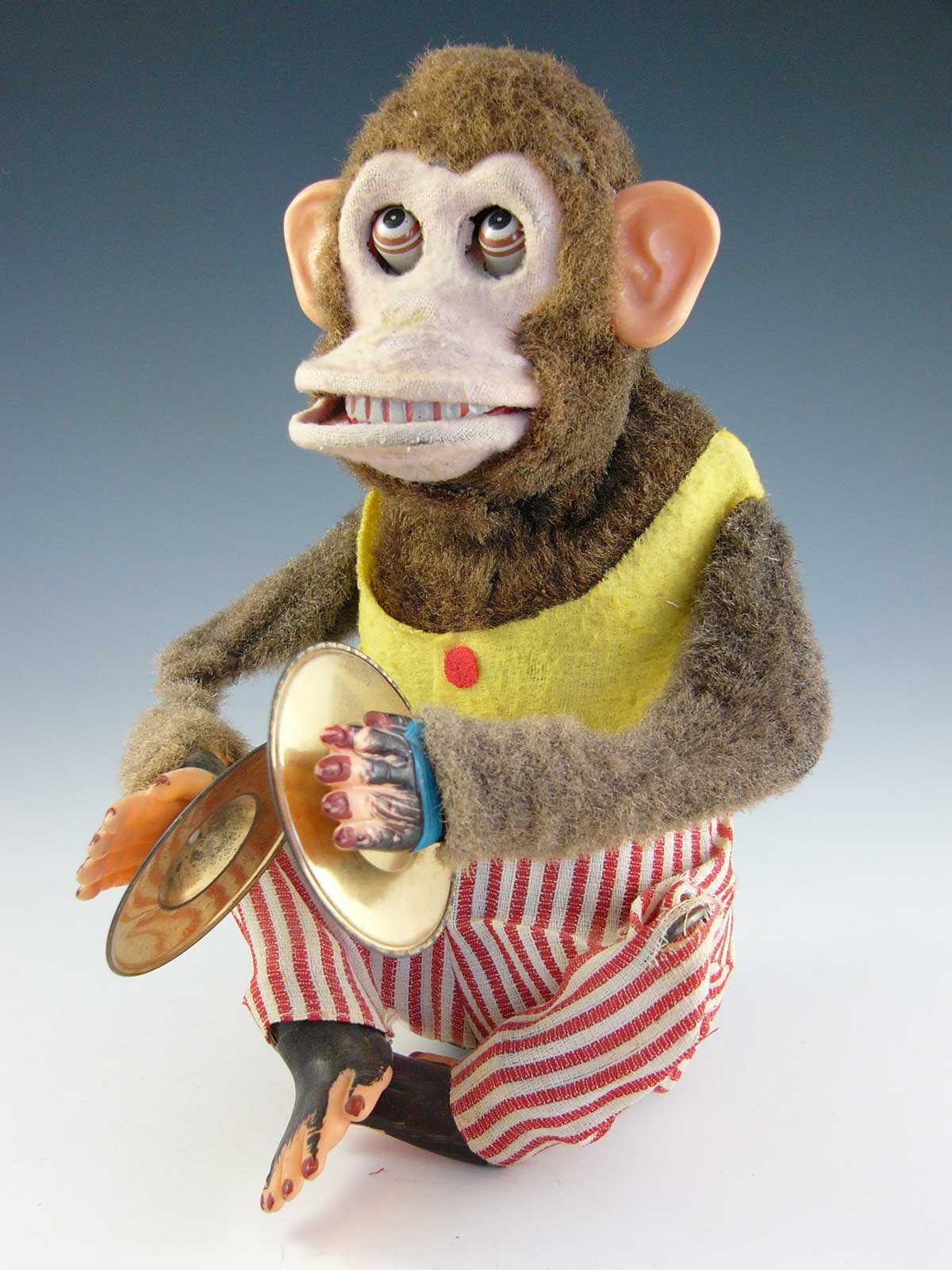March 2025
SMACK DAB IN THE MIDDLE
Batteries not included – some toys keep going and going…
by Donald-Brian Johnson
Toys are for kids, right? Well… except those intended for “kids at heart,” like the battery-operated figures which hopped off store shelves and into customers’ shopping bags in the 1950s and ‘60s. Parents took one look at the gleeful “Monkey Clanging Cymbals,” or the dainty “Dog Lady Watering Flowers,” and said to themselves, “Now wouldn’t the kids get a kick out of that?”
And they did—for awhile, at least. Battery figures required little interactivity. You turned on Mr. Monkey, watched him clang his cymbals, and then what? Back in the box he went.
The truth was, as toy manufacturers quickly discovered, that kids weren’t the ones getting a kick out of these battery wonders. It was the actual buyers (i.e., their parents) who were getting the kick, thinking how much fun it would have been to own one of these toys back when they were kids. That’s why so many of the battery ops eventually found their way to a shelf in Dad’s den. And that’s why so many of the figurine themes were a bit further afield than what authentic kids might be thinking about. (Really, how many boys and girls spent their days dreaming about owning a “Charley Weaver Bartender” or a “Pipe Smoking Rat”?)
The earliest “battery toys,” dating from just after World War II, were essentially “mechanicals.” Friction, or a wind-up spring-driven motor provided any movement. Battery-powered components were just there to offer a little something extra – car head-lights that actually lit up, or a noisy police siren.
Wind-up toys only ran as long as their wind-up lasted. Then it was time for another turn of the key. Japan’s intro-duction of miniature battery-powered motors in the late 1940s meant that toys could essentially run forever (or at least until their batteries wore out). Even better, battery-operated toys could be designed to perform what-ever imaginative actions came to the designer’s mind. “Piggy Cook” could merrily sprinkle seasoning on his latest entrée. . . “Teddy The Boxing Bear” could deter-minedly attack his punching bag… and the “Down The Hatch Sea Captain” could send another healthy slug…well, “down the hatch.” With some battery figures, the actions were even more ingenious: Magnetic fish helped the “Fishing Bear” reach his daily limit; “McGregor the Cigar Smoker” actually blew “smoke” from his cigar, while the “Bubble Blowing Bunny” did just that.

All set to sprinkle on the seasoning: “Piggy Cook.” (Image courtesy of the author)

A crashing success: The “Monkey with Cymbals” rolls his eyes each time the cymbals clang. (Image courtesy of the author)
Although some battery ops carried domestic company names (Cragstan, Ideal, Marx), the majority were manufactured in Japan, and then made available to U.S. distributors. While many imports carried no maker mark, one of the best-known Japanese manufacturers, Masudaya Modern Toys, utilized a diamond logo, encasing the letters “M-T” (During the space-age ‘60s, one of M-T’s most popular creations was the 15-inch “Giant Sonic Robot,” which came complete with whistling sound effects, and an array of flashing lights).
Originally, battery figures were very budget-friendly, retailing at $20 and under. So why aren’t today’s store windows filled with rows of grinning Charley Weavers? Well, the move to plastic in the late 1960s meant tin battery toys could now be manufactured even more inexpensively, resulting in greater profits at the same selling price. Plastic toys proved more reliable, too, not subject to the mechanical malfunctions (and rust) which plagued metal toys.
While today’s collectors are unlikely to find any battery toys at $20 and under (any working ones, that is), prices remain relatively friendly in the $100-$200 range (although Holy Grails like the “Sonic” can command up to $5,000). Original boxes, which often include operating instructions, add to the value. While minor imperfections, such as corroded battery terminals, can often be easily remedied, toys with non-working major functions are best left in the hands of hobbyists with plenty of skill and lots of time. That’s why it’s best to test out your favorites before purchasing. And be sure to bring along a few batteries. As the boxes always said, “Batteries Not Included.”

